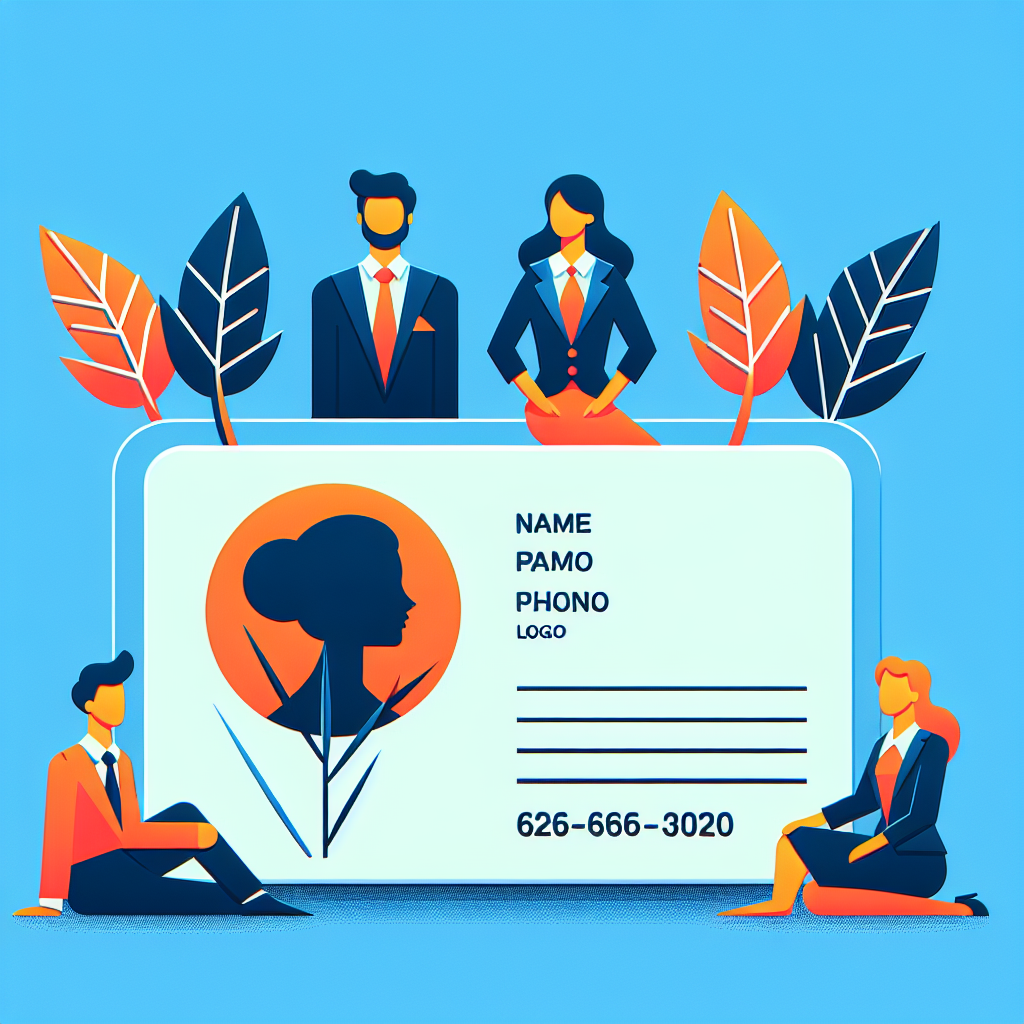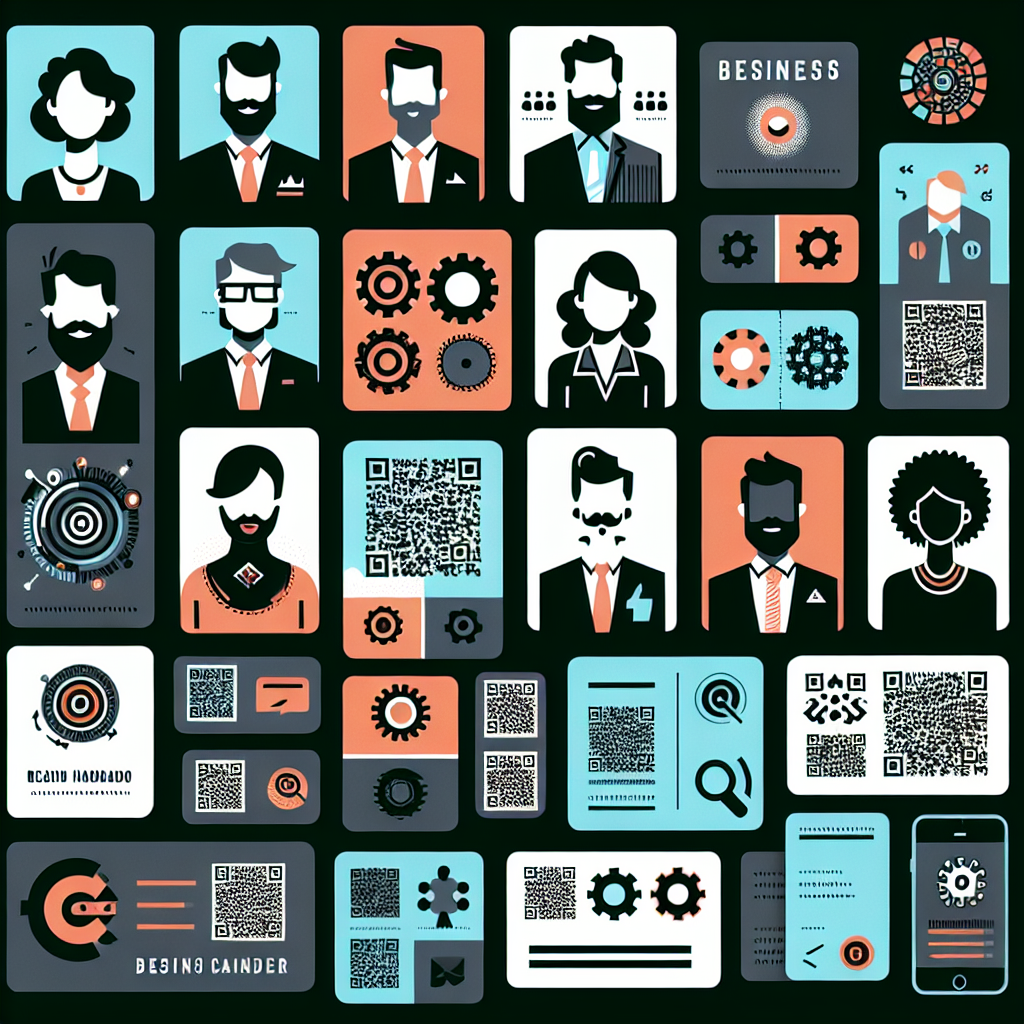What Makes a Memorable Company Business Card Example? Discover Key Elements!
Have you ever been handed a
company business card example that you couldnt forget? It’s not just about the contact information; it’s about creating a lasting impression. Todays business world moves fast,
and in the rush, that tiny card can either stand out or disappear completely. So what are the key elements that transform a simple card into a memorable
example of a good business card? Lets dive in!
First and foremost, a business card should clearly communicate who you are and what you do. That means including your logo, name, and essential contact information like phone number, email, and
website. But here’s the twist: make sure the font is readable. Have you ever squinted at a card trying to decipher tiny letters? Not ideal!Here’s a quick checklist: - ✔️
Name prominently displayed - ✔️
Logo for
brand identity - ✔️
Contact Information: phone, email, and
website - ✔️
Social Media Handles (if relevant) By including these elements, youre not just handing out a card; youre offering an introduction to your
brand.
Visual Impact: Design Matters!
A study showed that 75% of consumers judge a companys credibility based on their
business card design. Wow, right? Thats why discussing
business card examples is essential. For instance, cards with vivid colors or unique textures can create excitement. Imagine receiving a card with a matte finish that feels luxurious to touch.
Examples of cool business cards often feature innovative designs:-
Die-cut shapes: Think outside the rectangle! -
Bold colors: Make your card pop! -
Unique materials: Wood, metal, or even recycled paper.Choose designs that align with your brand’s message. If you’re in
finance, perhaps a more polished, professional look works better than quirky designs. Its all about knowing your audience!
Captivating Content: Your Value Proposition
Incorporate a
value proposition into your card. What sets you apart in your industry? Are you the go-to for tech solutions? Maybe you offer unparalleled
customer service. For instance, you might say, “
20 years of experience in
software development!” This approach transforms your card from a simple informational tool into a conversation starter.
Engaging content could also include:- A
short tagline capturing your mission- A
QR code linking to your website or LinkedIn- A
call to action like “Let’s connect!” or “Check out our latest project!”Remember, its not just about presenting yourself, its about creating a connection over time.
Examples of Successful Business Cards: Real-Life Success Stories
Let’s look at a few
examples of successful business cards. One of our clients had been struggling with
networking events. They created a business card that not only presented their contact information but also included snippets of their portfolio. After handing it out, they saw a
30% increase in their follow-ups! This is a prime example of how a thoughtful approach can enhance networking.Another client focused on sleek design with a matte finish and simple white text. They reported that during meetings, clients often complimented the card, which led to more discussions about their services.
Don’t Overlook Practicality: Keep It Portable
While it’s tempting to go wild with creativity, remember to maintain practicality. The card should fit easily into wallets and cardholders. The standard size is about
3.
5 x
2 inches. Also, consider using quality cardstock—nothing says "I value my business" like a well-made card! Some
examples of cool business cards even use rounded corners or fold-out designs to stand out while remaining user-friendly.
Expert Insight: Collect and Iterate
Here’s a pro tip: after your cards are printed, don’t just leave them in a stack! Get feedback from peers or clients. What do they think about the design? Would they notice changes? Use their insights to refine your approach for future iterations. So, are you ready to create a
business card example that resonates with
people? With over
20 years of experience, our team at
webmaster.md is here to help you craft that unforgettable impression. Call us at
+373 601 066 66 or visit our website to learn more about how we can assist with your
branding needs!
| Card Feature | Example | Effectiveness |
|---|
| Unique Material | Wooden Finish | Stands out, memorable visual |
| Bold Colors | Fluorescent Pink | Attracts attention |
| QR Code | Directs to Portfolio | Easy access to info |
| Tagline | "Innovate Your Business" | Engages potential clients |
| Die-Cut Design | Shaped like a tool | Unique & easy to remember |
| Informative Back | Portfolio Highlights | Encourages follow-up |
| Call to Action | "Let’s Connect!" | Incorporates interaction |
| Size Consideration | Standard Dimensions | Easy to store |
| Quality Cardstock | Thicker Paper | Feels professional |
| Round Corner Design | Sleek Profile | More user-friendly |
Next time you attend a networking event or hand out your card, remember these key elements. Are you ready to elevate your business card game? Let’s turn those
business card examples into your own success story!
How to Design an Example of a Good Business Card: Tips and Techniques
Designing a great business card goes beyond just choosing colors and fonts. Its about crafting a small yet powerful marketing tool that effectively communicates your brand, captivates your audience, and encourages meaningful connections. Are you ready to dive into the world of
business card design with some practical tips and techniques? Let’s get started!
1. Start with a Clear Vision
Before you grab your
design software, think about what you want your card to convey. What does your brand represent, and what impression do you want to leave? Whether its modern, classical, quirky, or professional, hold onto that vision as you create your design.- ✔️ Define your
target audience: Who will be receiving your card?- ✔️ Identify your brand message: What key concepts do you want to communicate?- ✔️ Decide on a theme: Will your card match your brand’s website or other
marketing materials?
2. Choose the Right Size and Shape
While the standard business card size is
3.
5 x
2 inches, don’t be afraid to think outside the box. Creative shapes can help your card stand out but make sure they’re practical. If the card is too large, it might get lost in wallets; if it’s too small, it may be easily overlooked. Consider these options: - ⭐ Traditional rectangle: The classic choice that fits easily in wallets. - ⭐ Square: Adds a modern twist and plenty of room for design. - ⭐ Custom shapes: Think about die-cut designs that represent your business—like a tool for a handyman!
3. Select Eye-Catching Colors
Colors evoke emotions, so choose a palette that aligns with your
brand identity. According to studies, up to 85% of consumers make purchasing decisions based on color! Tip: Use complementary color schemes to create visual harmony. Here are some common color associations: - ⭐ Blue: Trustworthy and dependable - ⭐ Red: Energetic and bold - ⭐ Green: Growth and health - ⚫ Black: Luxury and elegance Think about how your color choices reflect your brand!
4. Pick the Perfect Fonts
Your font selection plays a crucial role in how your card is perceived. Aim for clarity while also promoting your
brand personality. -
2-3 Fonts Max: Too many styles can clutter your design. Stick to
2-
3 for a clean look.-
Hierarchy: Your name should stand out, followed by your title and contact information.-
Legibility: Choose fonts that are easy to read at various sizes. For example, a creative agency might use a playful typeface for their name but opt for a clean sans-serif for contact info. This combination can showcase creativity while ensuring clarity.
5. Utilize Quality Imagery
Incorporating high-quality imagery or logos can enhance the overall appeal of your card. Whether it’s a logo, unique graphics, or a personal photograph, ensure images are high resolution to avoid pixelation when printed.- ⭐ Use
vector graphics: These can scale without losing quality.- ⭐ Avoid clutter: One dominant image will work better than multiple competing elements.
6. Craft a Memorable Tagline
A catchy or memorable tagline can serve as a conversation starter. It provides context about your business and draws people in. For example, a graphic designer might use a tagline like “Capturing Your Vision in Every Pixel,” which effectively conveys their passion and expertise. If you don’t have a tagline yet, think about what makes your business unique and come up with a few options.
7. Incorporate Contact Details Wisely
The effectiveness of a business card hinges on the ability to connect with potential clients. Make sure your contact info is clear and easy to find. Include:- ✔️ Your name- ✔️ Your job title- ✔️ Phone number- ✔️ Email address - ✔️ Website
URL Don’t forget to include relevant
social media links if applicable! Utilize icons to represent each social platform, making them easily recognizable.
8. Leave Room for White Space
Don’t overcrowd your card! Adequate white space helps important details stand out and gives the card a clean look. It allows for a natural flow of information, making it easier to read. As a rule of thumb, aim for
30-
50% of the card to be white space. This technique prevents information overload and enhances
visual appeal.
9. Get Feedback and Test Print
Before finalizing your design, never skip the step of gathering feedback. Sharing your design with friends or colleagues can provide valuable insights. Is it visually appealing? Does it convey the right message?Once you’ve made adjustments, print a test copy. Review it in hand to check how it feels and looks; you might spot details that need tweaking!
10. Partner with Professionals
If design isnt your strong suit, consider teaming up with professionals like our experts at
webmaster.md. With
20 years of experience in graphic and
software development, were the right choice to help you create an unforgettable business card tailored to your needs. Contact us at
+373 601 066 66 or check out our
comprehensive services on our website at
webmaster.md. Let’s craft a card that truly reflects your brand!Ready to elevate your networking game? Start designing your example of a good business card today!
Why Exploring Business Card Examples Can Transform Your Networking Approach
When was the last time a business card made you stop and think? It’s incredible how something so small can have a big impact on networking. Exploring
business card examples can completely change your approach to making connections and building relationships. But how? Let’s delve into the reasons why studying these examples can enhance your networking game!
Looking at a variety of
examples of cool business cards can spark your creativity! You might find a layout, color scheme, or unique feature that you hadn’t considered. For example, a card featuring a quirky die-cut shape could inspire you to break away from the standard rectangle.When you see innovative designs:- ⭐ You might think outside the box: Do you want to incorporate a playful illustration that represents your business? - ⭐ You can evaluate trends: Perhaps a minimalist aesthetic resonates with your brand more than a busy pattern.By gathering design inspiration, you’ll develop a vision for a business card that stands out and speaks directly to your audience.
Every successful business card communicates essential information about the individual and their business. By analyzing existing
examples of successful business cards, you can learn how to convey your message succinctly and effectively.For instance, a well-designed card clearly presents:- Your full name- Job title or role- Company name and logo- Contact informationStudying various card examples can help you identify what details resonate with potential contacts, so you can design your card to make that immediate impact.
3. Identifying Key Trends in Your Industry
Every industry has its own set of standards and trends when it comes to business cards. For instance, an architect’s card might lean towards sleek and modern, while a florist may embrace vibrant colors and playful graphics. By exploring various examples, you’ll gain insights into what works best within your niche.Here’s how recognizing these trends can transform your networking:- ⭐ You can set yourself apart: By knowing what’s typical in your industry, you can choose to differentiate yourself with a unique design.- ⭐ You’ll resonate better with your audience: A card that reflects current trends will feel relevant and engaging. Keeping up with
industry trends enhances your credibility and helps create a positive first impression.
4. Building a Personal Connection
Business cards are more than just contact details; they’re often the first physical connection you make with someone. A thoughtful design can trigger emotions and create lasting memories. An example of a card that tells a story or evokes a specific feeling will do wonders for your networking.Think about:- ⭐ Adding a personal touch: Include a quote or tagline that resonates with your brand’s mission.- ⭐ Incorporating imagery: Using photographs that highlight your products or services can create a visual connection.Cards that foster personal connections will likely lead to more meaningful conversations and collaborations.
5. Encouraging Conversation Starters
A well-designed business card can serve as a fantastic icebreaker. When you hand over a card that you’re proud of, it can lead to questions about your design choices or tagline. For example, if your card features a custom illustration, the recipient will likely ask about its significance, giving you a chance to share your story.To enhance your cards potential as a conversation starter:- ❓ Incorporate a QR code for instant access to your portfolio or website. - ⭐️ Add an engaging tagline that highlights your
unique selling proposition.This tactic will not only invite the recipient into a conversation but also make your card memorable.
6. Reflecting Professionalism
Nothing screams “professional” like a well-crafted business card. Taking the time to explore quality
business card examples sends a message that you care about your brand. A thoughtful design shows that you consider every detail important.Benefits of a polished business card include:- ⭐ Impressive meetings: When you present your card confidently, it leaves a lasting impression.- ⭐ Increased referrals: People are more likely to recommend you if they see you as professional and detail-oriented.Remember: your business card represents you in every networking situation, so invest time in making it shine!
Real-life success stories of individuals who utilized specific card designs can inspire you. Consider how a particular
networking strategy led to increased referrals or collaborations simply because of an eye-catching card.For instance, a client we worked with once shared that after redesigning their business card based on successful examples, they noticed a
50% increase in follow-ups from potential clients. The card served as a standout tool in their networking efforts, leading to meaningful connections.Such stories highlight the significant
ROI of investing in your
business card design.
8. Making it a Memorable Keepsake
In a world where everything is digital, a physical card can be refreshing and memorable. Exploring unique examples will encourage you to create a card that others will want to keep. Whether it’s through high-quality materials, unusual shapes, or standout visuals, a memorable card can transcend its primary purpose.Create a card that:- ⭐ Pop out and is appealing: Use special finishes like embossing or foil stamping for an elevated feel.- ⭐ Leave a mark: Include something unexpected or fun—perhaps a fold-out feature revealing more information.A memorable card may remain in a wallet longer and become a great conversation piece later!Are you ready to transform your networking approach using the insights and techniques from exploring
business card examples? With our expertise at
webmaster.md, we can help you craft a unique card that speaks volumes about your brand. Give us a call at
+373 601 066 66 or visit our website for more information!
When to Use Examples of Successful Business Cards to Boost Your Brand Identity
In the dynamic world of business, your
brand identity plays a vital role in how clients and partners perceive you. A memorable business card can reinforce that identity, but knowing when to leverage
examples of successful business cards is equally important. Let’s explore key opportunities where these examples can significantly amplify your brand!
Networking events are prime opportunities for showcasing your identity. When you hand out your business card, it serves as a tangible reminder of your conversation. By using successful business card examples as inspiration, you can design a card that captures attention amidst the crowd.- ⭐
Tip: If your card features vibrant colors or unique textures, it may lead to more engaging discussions. When recipients remember your card, they’re more likely to recall your company.Think about how you want your card to be perceived at these events. Do you want to be seen as innovative, trendy, or traditional?
2. At Trade Shows and Expos
Trade shows and expos are overflowing with competitors, and a remarkable business card can help you stand out. When countless similar businesses are vying for attention, using striking examples from successful cards can transform your networking results.- ⭐
Tip: Display your card in a holder or as part of your booth’s design to attract interest. Having a card that reflects your brand’s
unique selling points can capture leads and create lasting impressions.Align your design with your booth’s theme to elevate the overall attendee experience!
3. With Client Meetings
Handing over your business card at the end of a client meeting can solidify their perception of your professionalism and attention to details. Using examples of successful business cards ensures that the card you present isn’t just a piece of paper—it’s a representation of your brand.- ⭐
Tip: Consider incorporating a personal touch, like a handwritten note on the card or a participatory aspect like a QR code directing them to your latest projects. You can also refer to visual elements that align with client interests discussed during the meeting, reinforcing your memory in their minds.
4. In Follow-Up Communications
When following up with potential clients or partners, referencing the business card you provided can create a sense of familiarity. Use your card to bridge the conversation, reminding them of your previous interactions.- ✉️
Tip: Include your business card in follow-up emails as a digital attachment or link. This reinforces your connection while adding a personal touch to the communication.Citing a detail or highlighting a service from your card in your follow-up can also drive engagement.
5. As Part of Promotional Materials
If you’re distributing promotional materials—be it at events, through mail
campaigns, or even gifts—incorporate your business card. By referring back to successful examples, you can enhance the overall presentation and ensure
consistent branding.- ⭐
Tip: Pair your business card with branded merchandise or leave-behind gifts. When recipients find your card within valuable items, it boosts the likelihood they’ll keep it for later reference.Use clear branding across all materials to strengthen your brand’s identity and cohesion.
If you’re a freelancer or entrepreneur, your personal business card serves as a reflection of you. By studying successful examples, you can incorporate unique aspects into your card that resonate with your own brand.- ⭐
Tip: Don’t shy away from creativity! Use visuals or taglines that speak to your personal values or professional philosophy. Whether you choose minimalistic designs or
vibrant graphics, let your card showcase who you are!
7. During Social Media Networking
When networking on social media
platforms like LinkedIn, sharing images of your business card can spark curiosity. Interested recipients may want to connect, leading to meaningful conversations about your services.- ⭐
Tip: Utilize platforms to showcase your
business card design.
Captivating visuals garner attention, turning your card into a digital calling card.
Engage your audience by asking for their thoughts on the designs, creating an interactive experience.
8. For Brand Launches or Rebranding Efforts
Launching a new brand or rebranding an existing one provides an ideal opportunity to introduce updated business cards. Use successful examples to inform your design and ensure it captures your audience’s attention.- ⭐
Tip: Create buzz by teasing your new
business card design through social media or
email newsletters. This keeps your audience excited and engaged. Incorporating elements that reflect your brand’s evolution can strengthen its identity and convey your message effectively.As you navigate these opportunities, remember that your business card is more than just a contact tool; it’s a crucial aspect of your
brand identity. Ready to boost yours? At
webmaster.md, our team of professionals is here to guide you through the
design process, crafting a business card that elevates your brand presence. Call us at
+373 601 066 66 or visit our website to learn more about our services!






